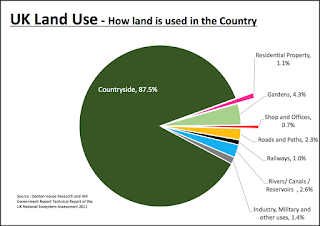The most recent set of data from the Land Registry has stated that
property values in Maidstone and the surrounding area were 4.4% higher than 12
months ago and 17.91% higher than January 2015.
Despite the uncertainty
over Brexit as Maidstone (and most of the UK’s) property values continue their medium and long-term
upward trajectory. As economics is about supply and demand, the story behind
the Maidstone property market can also be seen from those two sides of the
story.
Looking at the supply issues of the Maidstone property
market, putting aside the short-term dearth of property on the market, one of the
main reasons of this sustained house price growth has been down to of the lack
of building new homes.
The
draconian planning laws, that over the last 70 years (starting with The Town and Country
Planning Act 1947) has meant the amount of land built on in the UK today, only
stands at 1.8% (no, that’s not a typo – its one point eight percent) and that
is made up of 1.1% with residential
property and 0.7% for commercial property. Now I am not advocating building modern
ugly carbuncles and high-rise flats in the Cotswolds, nor blot the landscape with
the building of massive out of place ugly 1,000 home housing estates around the
beautiful countryside of such villages as Hunton, Hollingbourne and East
Farleigh.
The facts are, with the restrictions
on building homes for people to live in, because of these 70-year-old
restrictive planning regulations, homes that the youngsters of Maidstone badly
need, aren’t being built. Adding fuel to that fire,
there has been a large dose of nimby-ism and landowners deliberately sitting on
land, which has kept land values high and from that keeps house prices high.
Looking at
the demand side of the equation, one might have thought property values would
drop because of Brexit and buyers uncertainty. However, certain commenters now
believe property values might rise because of Brexit. Many people are risk
adverse, especially with their hard-earned savings. The stock market is at an
all-time high (ready to pop again?) and
many people don’t trust the money markets. The thing about property is its
tangible, bricks and mortar, you can touch it and you can easily understand it.
The Brits have
historically put their faith in bricks and mortar, which they expect to rise in
value, in numerical terms, at least. Nationally, the value of property has
risen by 635.4% since 1984 whilst the stock market has risen by a very similar 593.1%.
However, the stock market has had a roller coaster of a ride to get to those
figures. For example, in the dot com bubble of the early 2000’s, the FTSE100
dropped 126.3% in two years and it dropped again by 44.6% in 9 months in 2007…
the worst drop Maidstone saw in property values was just 20.05% in the 2008/9
credit crunch.
Despite the slowdown
in the rate of annual property value growth in Maidstone to the current 4.4%,
from the heady days of 13.39% annual increases seen in mid 2010, it can be
argued the headline rate of Maidstone property price inflation is holding up
well, especially with the squeeze on real incomes, new taxation rules for
landlords and the slight ambiguity around Brexit. With mortgage rates at an
all-time low and tumbling unemployment, all these factors are largely
continuing to help support property values in Maidstone (and the UK).










